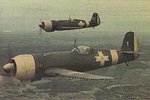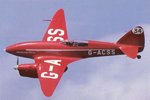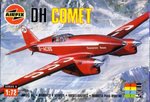Elvis
1st Sergeant
Kool Kitty,
Thanks for the clarification on the radiator / oil cooler locations on the P-40.
Much obliged.
As for the mentions of the P-51's radiator intake, yes, aestetically, it's a very nice and effective piece of hardware.
However, its design constituted that whatever plane it was attached to be a fighter, primarily.
Anyone who has any knowledge of the F-51's "success" in the Korean conflict knows that that large scoop turned out to also be really great at catching debris due to strafing, which was a role it was pressed into during that time.
A lot of crashes due to engine failures caused by lack of coolant were reported (or so I've read/heard).
One other airplane that I like, aesthetically, was a swedish plane (I believe).
I think it was called a "Dragon" and I seem to remember it being described as an attack/observation airplane.
The pic I saw, which was in some magazine I had as a kid, showed a black twin engined airplane.
VERY sleek looking and the only time I ever saw one or ever saw mention of one.
The reason I think it was swedish is because I thought it was mentioned that it was made by Saab and can picture the white circle with the three inverted triangles on the side of the fuselage, which I believe signify's the Swedish Airforce.
Can't find any info, or even any mention of the plane on the web.
Anyone know what I'm referring to?
The "Dragon" name is only a guess. I could be totally off on that part.
Elvis
Thanks for the clarification on the radiator / oil cooler locations on the P-40.
Much obliged.
As for the mentions of the P-51's radiator intake, yes, aestetically, it's a very nice and effective piece of hardware.
However, its design constituted that whatever plane it was attached to be a fighter, primarily.
Anyone who has any knowledge of the F-51's "success" in the Korean conflict knows that that large scoop turned out to also be really great at catching debris due to strafing, which was a role it was pressed into during that time.
A lot of crashes due to engine failures caused by lack of coolant were reported (or so I've read/heard).
One other airplane that I like, aesthetically, was a swedish plane (I believe).
I think it was called a "Dragon" and I seem to remember it being described as an attack/observation airplane.
The pic I saw, which was in some magazine I had as a kid, showed a black twin engined airplane.
VERY sleek looking and the only time I ever saw one or ever saw mention of one.
The reason I think it was swedish is because I thought it was mentioned that it was made by Saab and can picture the white circle with the three inverted triangles on the side of the fuselage, which I believe signify's the Swedish Airforce.
Can't find any info, or even any mention of the plane on the web.
Anyone know what I'm referring to?
The "Dragon" name is only a guess. I could be totally off on that part.
Elvis










